For years, my kids and I have been cutting down our own Christmas trees—from a national forest, no less.
It’s been a beloved family tradition ever since we moved to Oregon and discovered that we could get a beautiful tree in the wild for only five bucks!
And it’s not just the chopping-it-down part that’s special (although we love to yell “Tiiiimberrrr!” as we watch it go down), it’s also the memories made around the day: the smell of fresh evergreens, the snowshoe and cross-country ski adventures we tack on, the little treats we bring in the car, the impromptu sledding and snowball fights, and the dinners we always grab at our favorite restaurants on the way home.
If you live in Oregon, cutting your own Christmas tree from one of the national forests here is a novel endeavor you must try at least once. And today, I’m going to spill a few secrets as to where, what, and how the best ways to go about it are.

Is it legal to cut down a tree in Oregon?
Waaait a minute… you mean you can just walk into a national forest and cut down any tree you want? Just like that?
Yes, it’s true. Many people are surprised to learn that not only is it perfectly legal to chop down a holiday tree in Oregon, it’s actually encouraged and managed by the National Forest Service.
Removing a tree to enjoy in your own home actually improves the overall health of the forest, as it helps allocate more sun, water, nutrients, and space to the rest of the trees. The U-cut program creates more favorable growing conditions in the national forests to ensure there will be harvestable trees in years to come.
In short, cutting down a Christmas tree (and creating a fun tradition while doing so) is one small way you can contribute to forest restoration. Here in Central Oregon, the program also preserves our ponderosa forests by thinning out other species that threaten to take over.
According to The Nature Conservancy and Deschutes Land Trust, in a post written for the Deschutes Collaborative Forest Project:
After nearly a century of fighting to keep naturally occurring, low-intensity fires out of our forests, many of our ponderosa pine forests in Central Oregon are becoming overgrown with small and medium-sized white fir trees. […]
Historically these white firs would have been kept at bay by the frequency of the natural fires that kept our pine forests healthy. That’s where you come in; by cutting your own white fir Christmas tree you’re playing part of the role that natural fires used to play and helping restore our forests—one Christmas tree at a time.
While they specifically call out white firs, there is typically no restriction on the type of tree you can harvest for your U-cut Christmas tree. (But always check with your local forest district, as some species may be prohibited in certain areas.)
There are rules about where and how to cut down a tree properly (which I’ll get to below), but for the most part, you can take your pick of almost any tree under 12 feet tall in Oregon’s national forests.
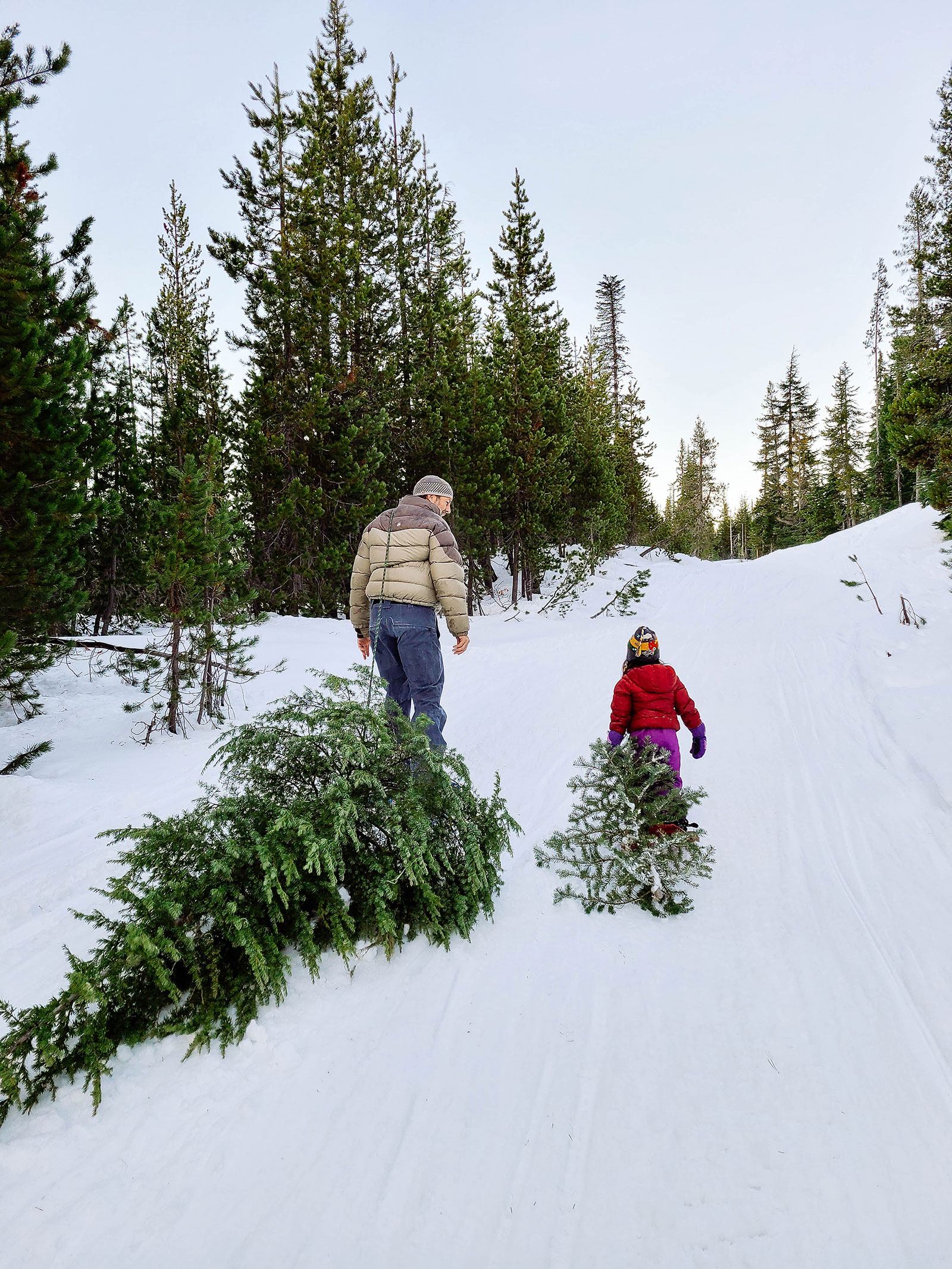
When do Christmas tree permits go on sale?
Recreation.gov, National Forest Service offices, and participating brick-and-mortar vendors typically start selling Christmas Tree Permits for Oregon in mid-November.
How much is a Christmas tree permit in Oregon?
Each Oregon Christmas Tree Permit costs $5 (up to a maximum of five permits per household). If buying online through Recreation.gov, there’s a $2.50 convenience fee added per order.
If you have a fourth- or fifth-grade student participating in the federal Every Kid Outdoors program, your family is eligible for a free tree permit.
How to get an Oregon Christmas tree permit
Before you head out, you’ll need to purchase an Oregon Christmas Tree Permit online, or from one of several brick-and-mortar vendors.
You can buy up to five permits per household. Each permit is good for one tree, no matter the size. This is where most people can’t believe that a freshly cut Christmas tree can be had for only $5!
To buy online, go to this page in Recreation.gov and type “Oregon” into the search box. A list of 12 national forests will pop up; select the one closest to you.

Specify how many trees you’d like to cut, pay, and print your Christmas Tree Permit instantly.
If you prefer to pick up the permit on your way to the forest, each Forest Service maintains a current list of all local vendors that sell tree permits. You can find one closest to you by selecting your forest district below:
- Deschutes National Forest
- Fremont-Winema National Forest
- Gifford-Pinchot National Forest
- Malheur National Forest
- Mt. Hood National Forest
- Ochoco National Forest
- Rogue River-Siskiyou National Forest
- Siuslaw National Forest
- Wallowa-Whitman National Forest
- Willamette National Forest
- Umatilla National Forest
- Umpqua National Forest
Hand them $5, they’ll hand you a fluorescent tree tag, and you’re good to go. Tree permits are not tied to any date, so you can even buy them a few days in advance. Occasionally, there’s a map available (just ask) that gives some clues as to where you can cut your Christmas tree.
Once you chop down your tree, affix the tag to the tree trunk and load it on your car. Just make sure the tag is visible during transport and you’re ready to bring it home!
Special Note
If you have a fourth- or fifth-grade child in your household, that student can participate in the federal Every Kid Outdoors program, which gives fourth- and fifth-graders a free Christmas tree permit (among many other cool benefits). All they have to do is fill in their pass/voucher number when they buy their tree permit online at Recreation.gov.
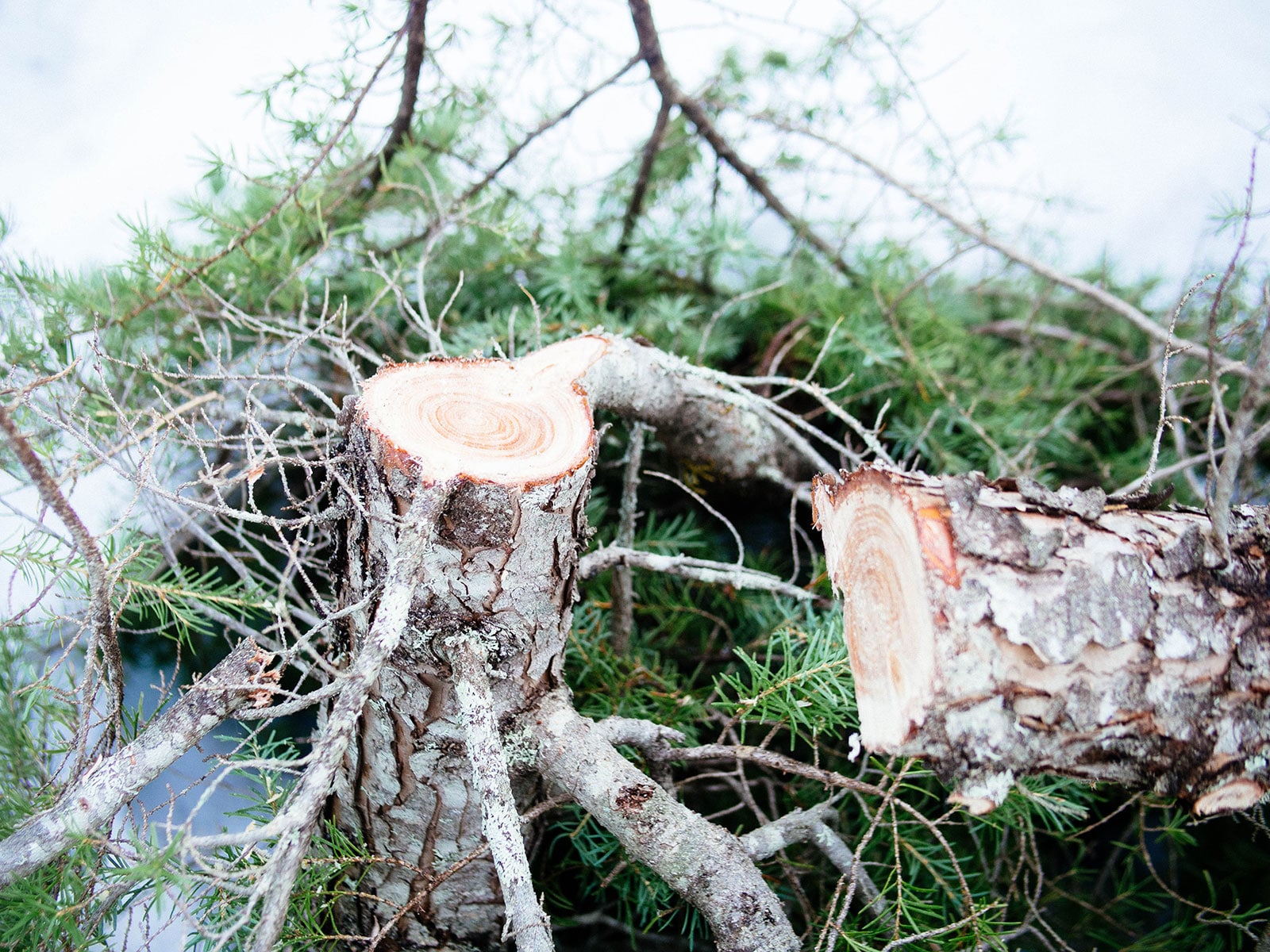
Rules for cutting a Christmas tree in a national forest
While Oregon is fairly lax when it comes to harvesting Christmas trees in its national forests, it certainly doesn’t want people taking down trees all nilly-willy.
So, the Forest Service has established a few ground rules:
- Don’t harvest trees within 150 feet of highways and developed areas, or within 300 feet of streams and other bodies of water
- Don’t harvest trees from private properties, young tree plantations, or designated wilderness areas
- Only cut a tree that’s within 20 feet of another one
- Don’t cut any tree taller than 12 feet (or 14 feet in Umatilla NF, 15 feet in Mt. Hood NF, 20 feet in Wallowa-Whitman NF)
- Don’t just take the top off a tree (you need to cut down the entire tree and take it with you)
- Cut the stump shorter than 12 inches
- Remove any branches from the stump and scatter them on the ground
(Note: These regulations are current as of time of writing, but always check with your local forest district for changes and exceptions.)
Ideally, you want to cut a tree from a densely forested area since it will help the forest thrive. When in doubt, follow the guidelines printed on the back of your tree permit. Please adhere to the rules to keep this lovely tradition going for future generations.
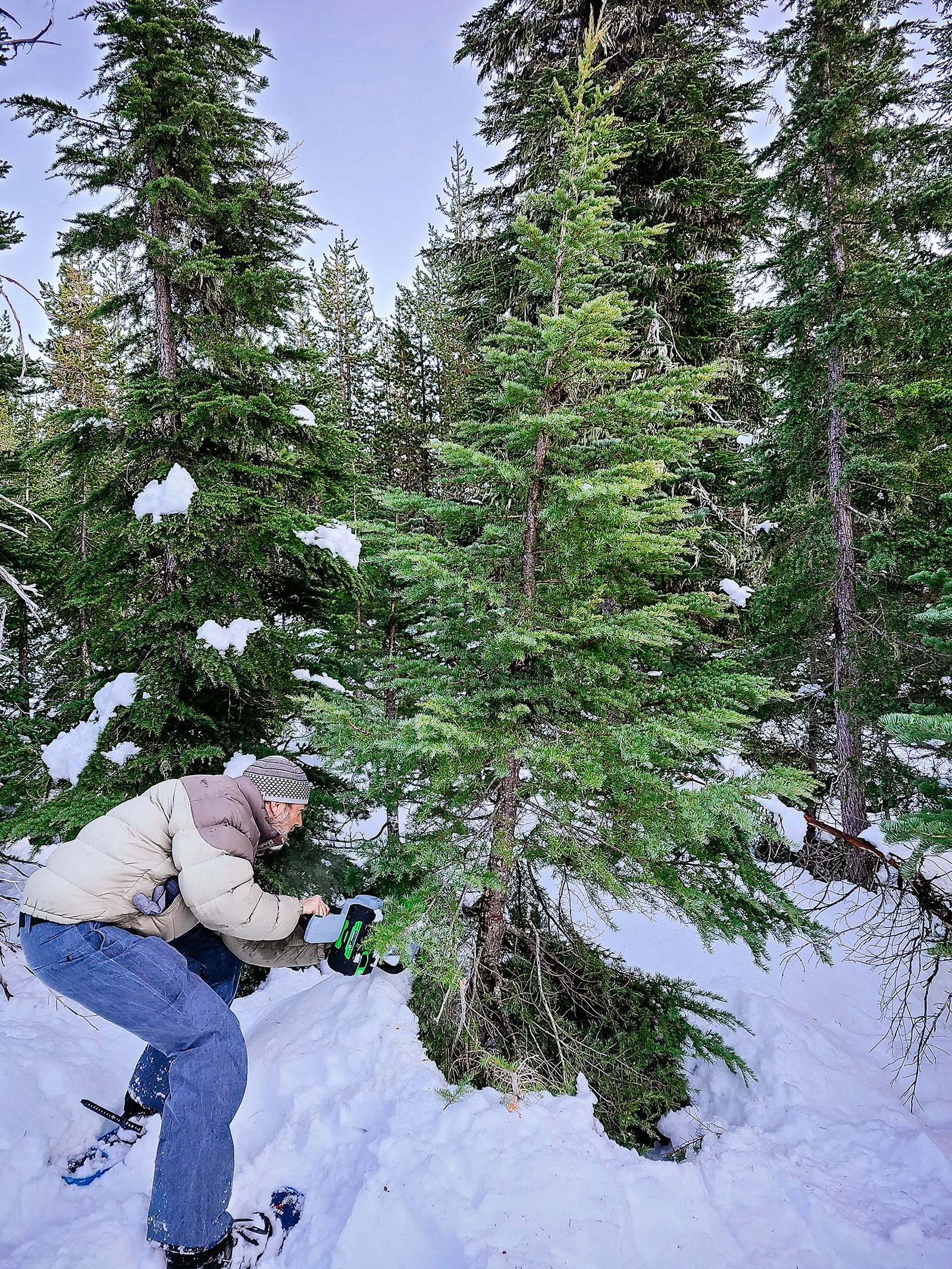
Choosing a tree
Although you can cut down a tree in many parts of Oregon, living in Bend, Oregon (where I am) has the advantage of being surrounded by national forest land. The town’s westernmost edge is bounded almost entirely by the Deschutes National Forest, an outdoor wonderland brimming with conifers of all types, depending on elevation.
At lower elevations near Bend and Sisters, you’ll mostly see lodgepole pines and ponderosa pines. Some people even harvest juniper trees as a quirky Christmas tree alternative!
Drive to higher elevations in the Cascades, and that’s where you’ll find the more coveted Douglas firs, white firs, incense cedars, and several types of spruces.
If you live over the hill near Mt. Hood or Willamette National Forests, the most common varieties are noble, balsam, Douglas, and Pacific silver firs.
The Noble fir is the top Oregon Christmas tree species, and in fact, the stately 75-foot-tall Capitol Christmas Tree in 2018 was harvested from our very own Willamette NF.
If you’re chopping your tree right after Thanksgiving and want to make sure it stays green through the holidays, check out my list of Christmas trees with the best needle retention (as well as Christmas trees with the shortest lifespans).
Quick Tip
When you’re out hiking in summer and spot a potential candidate for a Christmas tree, drop a pin or save the GPS coordinates on your phone. Then, you’ll know where to come back for your tree in winter! My husband and I also like to do this for potential new groves to explore that we’d otherwise miss when everything looks different under a blanket of snow.
One thing to know when hunting for your tree is that you’re not likely to find the fully symmetrical A-line tree you’re used to buying. Commercially grown trees are pruned throughout their life cycle for shape and size, and grow into perfectly bushy holiday centerpieces with help from irrigation. In the wild, the perfect tree is hard to find.
Related: Why the inner conifer needles on your evergreen tree turn yellow or brown
Conifers in a forest tend to have bald sides, can sometimes look a little scraggly, and aren’t always uniform in shape. Let’s just say… they tend to be more Charlie Brown, and less Hallmark card. But sometimes “almost perfect” turns into perfect when you consider the experience of it all.
When you find a good candidate, be sure to view it from all angles to make sure you’re happy with how it looks. If a certain tree you love is a bit bare on one side but otherwise full and fluffy everywhere else, you can place it against a wall where no one will notice the missing branches.
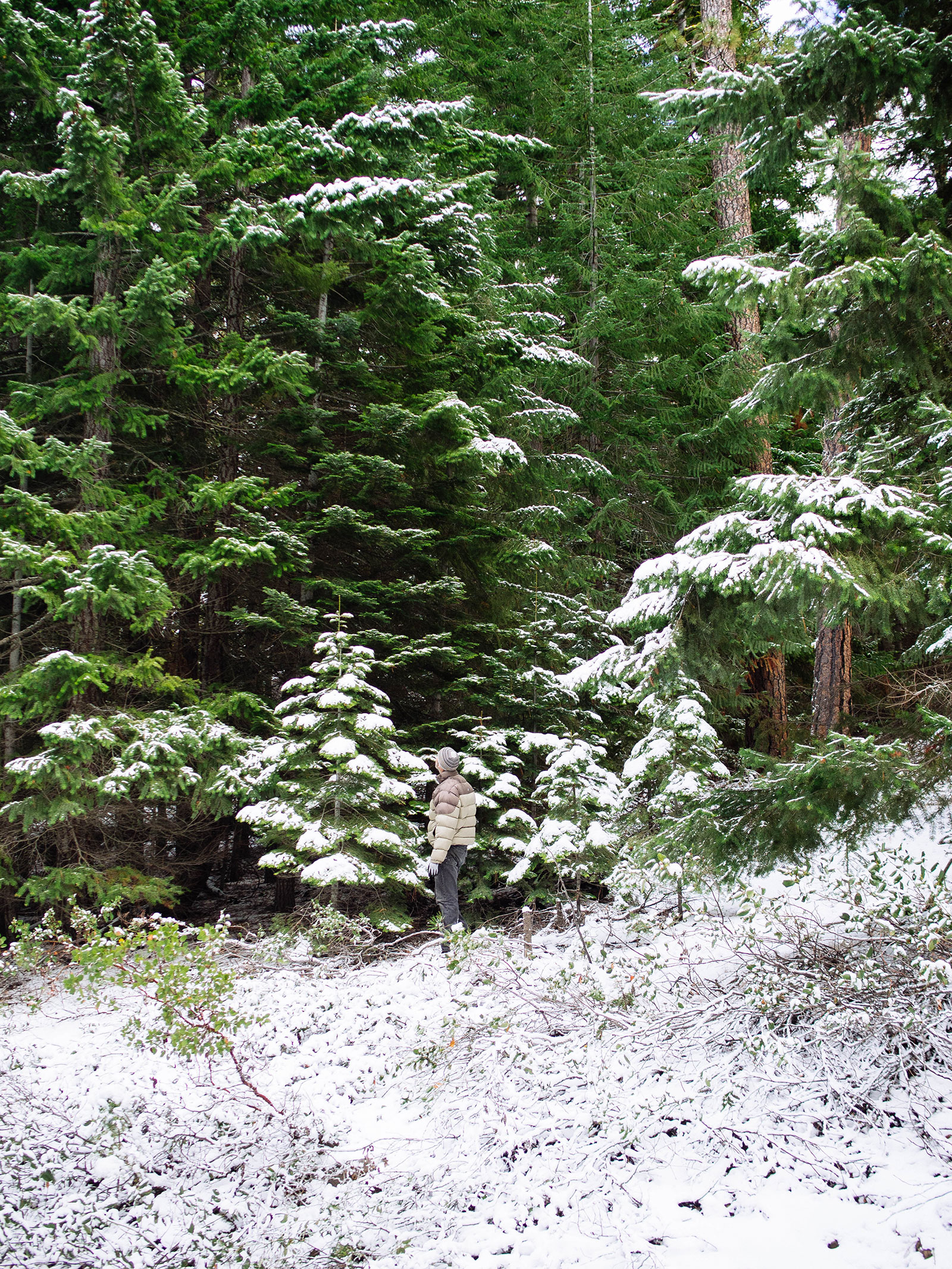
The best places to find and cut your own Christmas tree
Anyone who’s ever cut their own Christmas tree every year as a beloved tradition guards their secret spot with a passion. It’s like trying to find out where their favorite place to hunt for morels is!
But I’m willing to give up a few of my tried-and-true spots in Central Oregon because honestly, there’s plenty to go around and as you explore the forests, you’ll probably find your own special place that you’ll want to return to year after year.
Important Note
To park in most Sno-Parks (designated snow play areas), you’ll need an Oregon Sno-Park Permit. You can get this at any DMV office, sporting goods store, or participating retailer before you head out, and display it on your dashboard when you park.
So, where should you go to cut down your tree? A lot will depend on how adventurous you’re feeling.
If you want easy access, it doesn’t get any easier than Wanoga Sno-Park, just 14 miles southwest of Bend on Cascade Lakes Highway.
Yep, this is the same place where kids fly down steep icy sled hills on plastic discs, so you could make an entire day of it with your adrenaline-loving family.
There’s ample parking in the Sno-Park, which is plowed all winter, and you don’t even have to walk that far to find a tree.
My suggestion is to park on the westernmost end of the lot (near the trailers and toy haulers) and hike up the snowmobile paths into the surrounding forest. You’ll find plenty of fir trees here and can go as far as your legs will take you. (Though keep in mind you’ll be hauling a tree back out on the same trail!)
Virginia Meissner Sno-Park is another easy option just down the road from Wanoga, but the parking lot is smaller so it might get crowded on weekends.
If you can snag a parking spot, however, this is a fun place to snowshoe in search of your Christmas tree. (Just be sure you stay off the Nordic trails.) You can easily drag your tree back out on a sled; bring rope to secure it so you can pull it over your shoulder.
Honestly, you can’t go wrong anywhere in the Cascade Mountains and it’s only a 20- to 30-minute drive from Bend. Though Cascade Lakes Highway terminates at Mount Bachelor in winter, there are lots of pull-offs on the drive where you can park and head into the forest to find your tree.
Quick Tip
Most people don’t want to walk very far to hunt for and cut down their trees. That means the best trees along the forest roads tend to be targeted first and you’ll mostly find stumps in the more popular areas. But hike just a couple hundred feet in from the road, and your options widen much more.
Another Sno-Park I like is Ray Benson Sno-Park, about 22 miles northwest of Sisters. This spot is similar to Wanoga in that there are ski and snowmobile trails all over, so it’s easy to hike through the forest to find your perfect tree.
The only drawback is sometimes this place can be loud with exhaust fumes filling the air if you go on a busy weekend, and it’s hard to escape the noise since the trails are so popular with snowmobiles. But, the variety of trees here (including fir, spruce, and cedar) may be worth it.
If you get lucky and get the place almost to yourself, you also get to enjoy the mini sled hills on the edge of the parking lot (not official ones, just fun little hills to get a bit crazy on).
For an off-road adventure, a really neat place to explore is the forest near Tumalo Falls just outside of Bend. This is close to the radio tower that you can see from town, and on a clear day, you get gorgeous views of Mount Bachelor on your journey.
To get there, take Skyliners Road west, just past Skyliners Sno-Park. Once you cross the small bridge over Tumalo Creek, turn right onto Bearwallow Road. Follow this road as it climbs past the first switchback and continue on NF-4601 to the second switchback, where you’ll hang a left.
The road will start to level off and you can pull off anywhere in the next few miles to begin your hunt. If you have your heart set on an elusive fir tree, this is the place to find it!
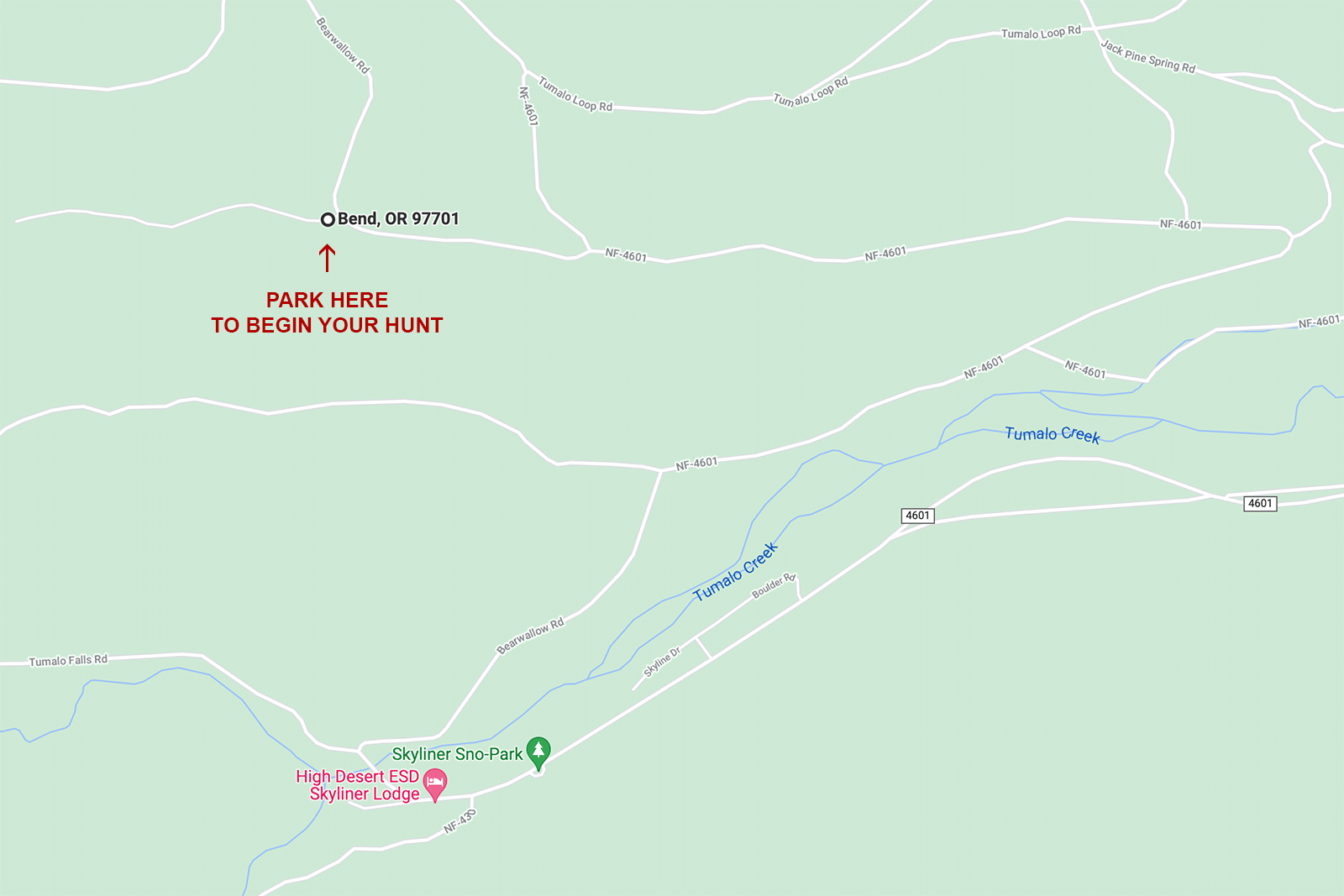
Another easy spot to find a fir tree is 47 miles south of Bend, near the town of Crescent. Take Highway 97 south and hang a right on Crescent Cutoff Road. You’ve got your pick of trees in the forest here—just pull off anywhere that looks like it has potential.
It’s a little farther for Bend residents (who typically end up near Mount Bachelor) but makes for a great day trip precisely because of that. You’re not going to find the same crowds on Thanksgiving weekend this far south, and any weekend after that, you’ll have the trails all to yourself.
My family likes to take Crescent Cutoff Road and keep going to Odell Lake, which is a hidden four-season gem. Out there, you can pack a picnic to enjoy lakeside or you can make a pit stop at Odell Lake Lodge for lunch or dinner. Or, you can plan ahead and book a stay in one of the cabins, with the Christmas tree cutting as your grand finale to the weekend.
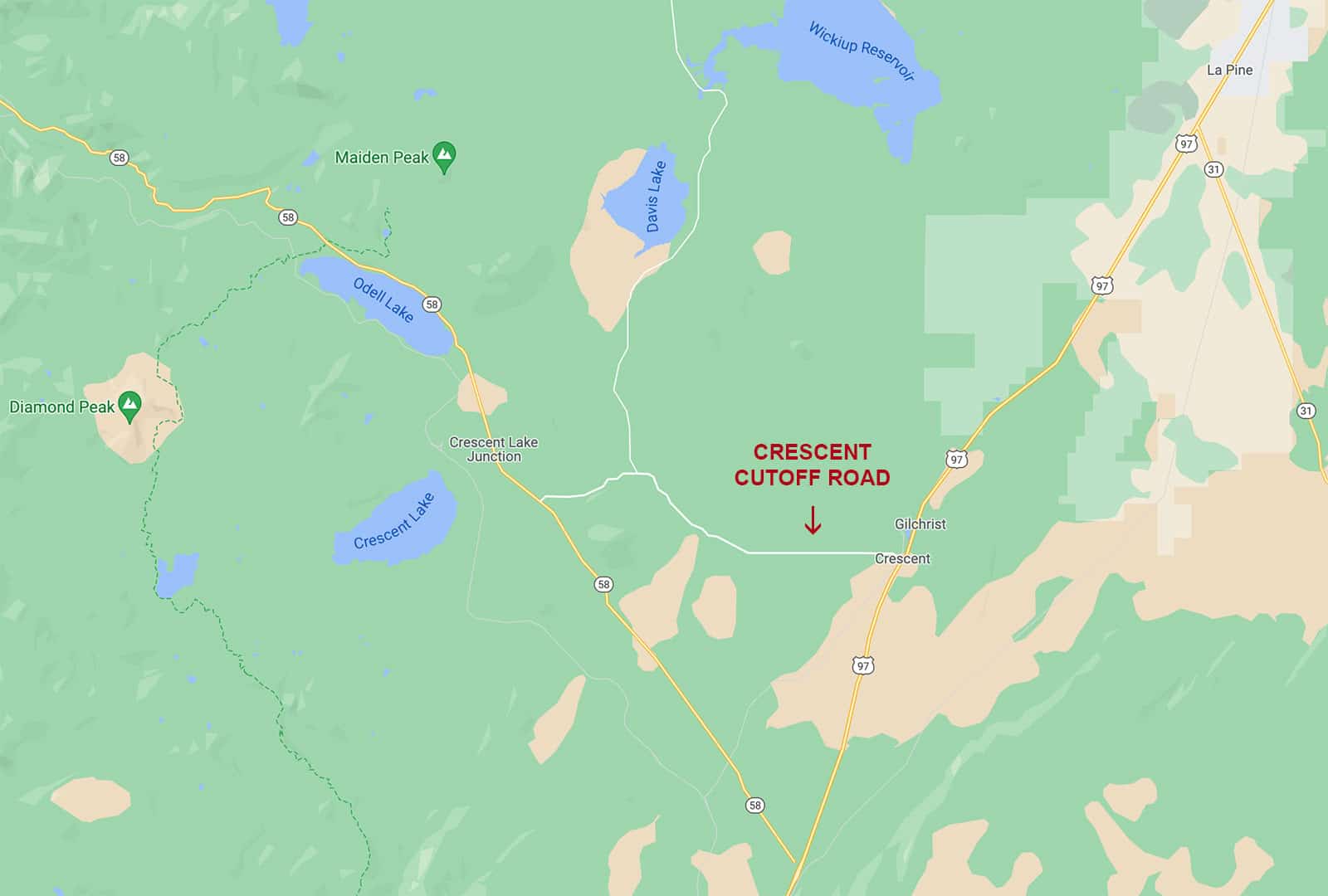
So, where do I personally like to go every year for my tree? Sshhhhh… I can’t divulge the exact location (wink) but I’ll say that my family and I like to head north toward Hoodoo Ski Area for our tree-cutting adventure.
We just love driving up the view corridor on Highway 20 when the Cascades are blanketed in snow. Any excuse we have to head that direction in winter, we take it.
I also adore spruce trees—they just feel very Christmas-y to me—and they’re much more prevalent in the higher elevations near Santiam Pass.
Even though we’ve been to all the places I mentioned above, our favorite—and one that we’ve built an all-day, action-packed tradition around with our kids—is still the Santiam area.

Safety checklist before you head out
Please learn from my friend Lisa, who documented her Christmas tree cutting adventure gone wrong. Thankfully her story had a happy ending, but it shows how an innocent excursion can easily turn into a bad situation (and in her case, a call to search and rescue).
1. Check the weather.
You might not want to head out for your tree-cutting adventure if the forecast is calling for snow. Remember that snow flurries in town can easily be several inches of snow at higher elevations, so plan your day accordingly.
2. Know where you’re going.
Have a couple of spots in mind before you leave the house, and know exactly how you’re going to get there. Be sure to download an offline map to your phone, or have a printed map with you. Cell reception is spotty to non-existent in the Cascades.
Check for road closures (I recommend using TripCheck) and avoid taking shortcuts, especially if there’s snow on the road. It’s easy to get sucked into the romance and adventure of picking the perfect tree, only to find the forest road you’ve been exploring suddenly gets too deep.
3. Make sure you have a full tank of gas.
It can happen to anyone. Waiting hours for AAA to come find you on a remote mountain road is not exactly a fun way to end your day.
4. Pack plenty of warm clothes and snow-proof layers.
The weather in Oregon is notoriously unpredictable, and what starts out as a warm, sunny day can quickly turn into a cold, stormy day with little warning. (Not to mention, temperatures in the mountains can fluctuate 30 degrees between morning and late afternoon when the sun sets.)
Always pack a few more layers than you think you’ll need, including a fleece, puffy coat, beanie, and gloves (preferably windproof/waterproof). Wear winter boots with non-cotton socks, and consider bringing waterproof gaiters or snow pants to keep you dry on your outing.
Kids invariably end up buried in snow (or slushy mud) in a fit of giggles, so pack their snowsuits and bring a change of clothes for them too. (Check out my tried-and-true mom recommendations for dressing babies and toddlers for cold winter weather.)
5. Bring snacks, water, and warm drinks.
Even if you don’t think you’ll be out more than a couple hours, throw a few protein bars in the car along with your trusty Hydro Flask.
I also like to bring a thermos filled with hot chocolate or hot cider as a post-hunt treat for the kids. (The grown-ups, meanwhile, prefer ours spiked with a shot of bourbon. “Liquid layers,” as I like to call it. This mulled wine recipe also hits the spot.)
For bonus points, fill a thermos with a hot, hearty chili to enjoy in the parking lot afterward!
6. Make sure you have all the tools and equipment you’ll need.
A fully charged phone, first aid kit, handsaw or chainsaw, and straps or tie-downs are the bare minimum of what’s required.
You might also want pruning shears to remove low-hanging branches; work gloves for dragging your tree back to the car; a tarp to protect the roof; a sled you can use to pull your tree through the snow; snowshoes, cross-country skis, or maybe even a baby chariot with a cross-country ski kit for exploring less accessible areas; and tire chains and a snow shovel (if you don’t have 4WD and winter-rated tires).
Emergency gear like flashlights and blankets are always a good idea, especially if you’re like my family and love to milk the whole day. We usually find ourselves traipsing out of the woods at sunset and more than once, we’ve ended a hike with headlamps on.
And of course, don’t forget your Christmas Tree Permit and Oregon Sno-Park Permit!
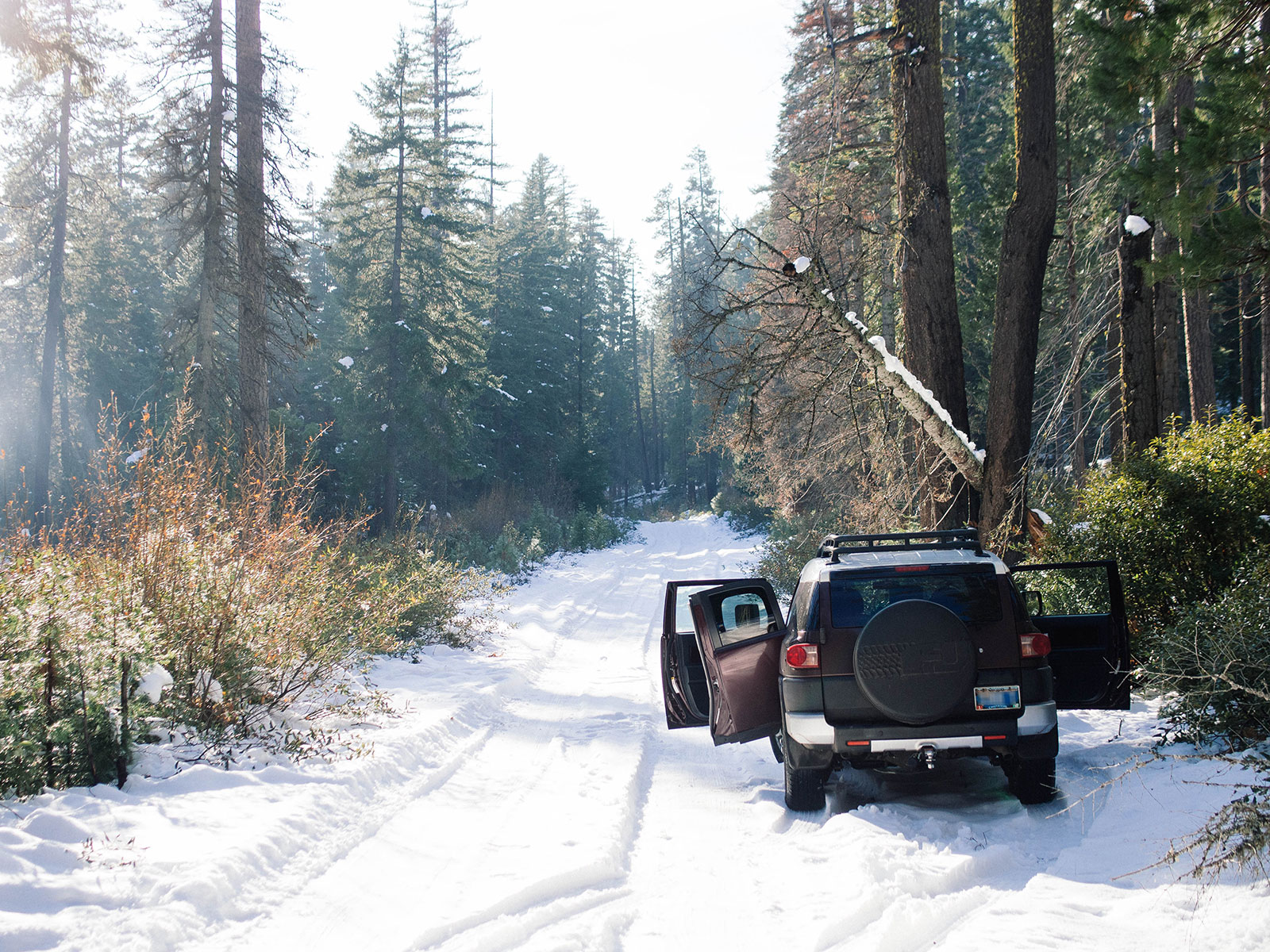
Disclosure: If you shop from my article or make a purchase through one of my links, I may receive commissions on some of the products I recommend.
U-cut Christmas tree essentials (don’t leave home without them!)
- Roadside first aid kid
- Handsaw or cordless chainsaw (that chainsaw is amazing—my husband loves his)
- Tie-down straps or rope
- Pruning shears
- Waterproof work gloves
- Multi-purpose tarp
- Sled
- Gaiters or snow pants
- Snowshoes
- Snow boots
- Emergency snow shovel
- Flashlight or headlamp
- Emergency blanket
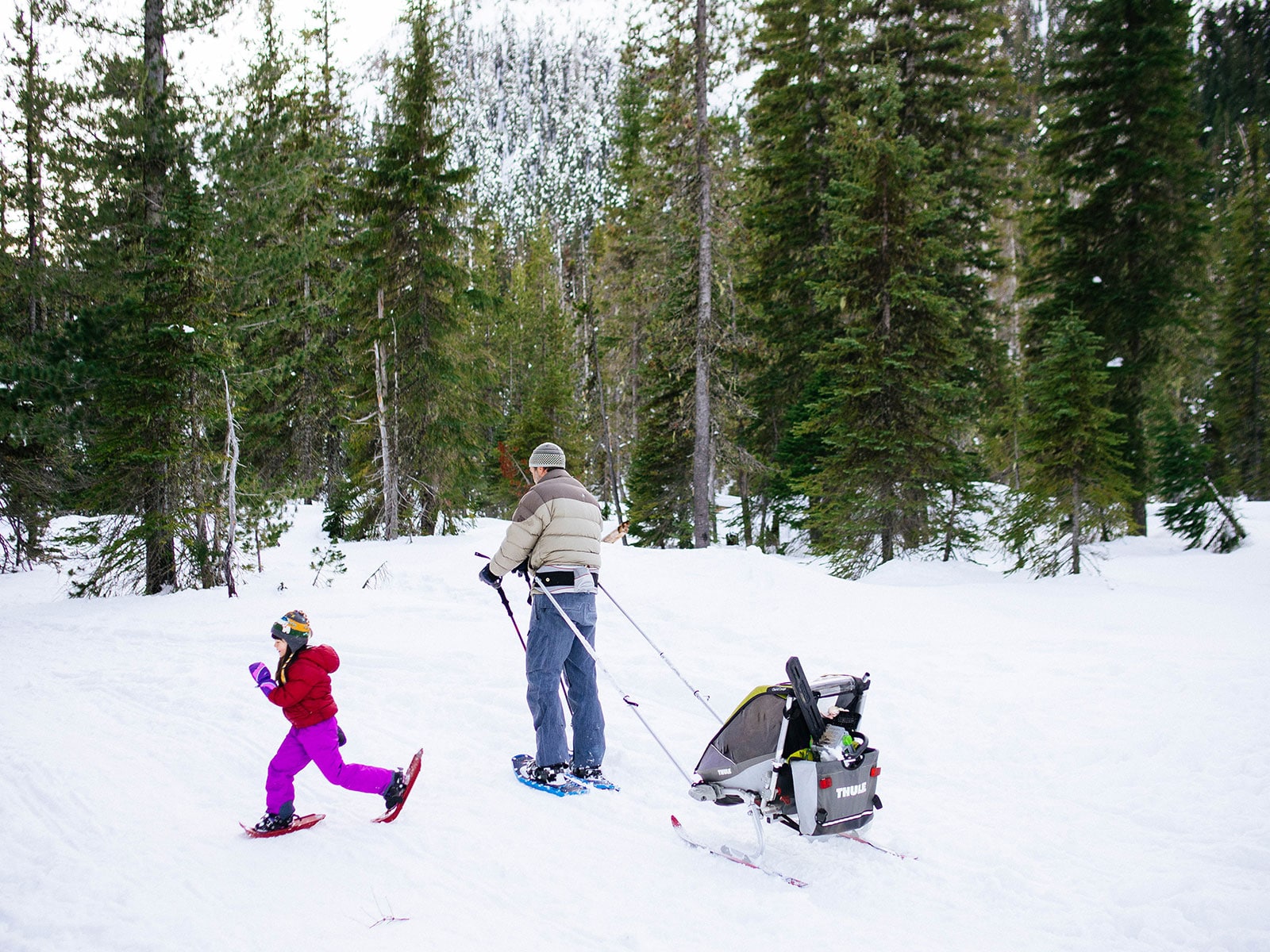
How to make your Christmas tree last longer
The beauty of cutting down your own Christmas tree in a national forest is you know exactly how fresh it is—which is key to helping your tree thrive and survive the holidays.
Follow these proven tips and tricks to make your Christmas tree last longer. These are the same steps I take every year to keep my tree (which we harvest right after Thanksgiving) looking beautiful for five weeks or more.
Once it reaches the end of its life, you can repurpose your old Christmas tree in many clever ways around your home and garden.
Is all of this sounding a bit too daunting? Consider getting a potted Christmas tree and planting it in your yard after the holidays!


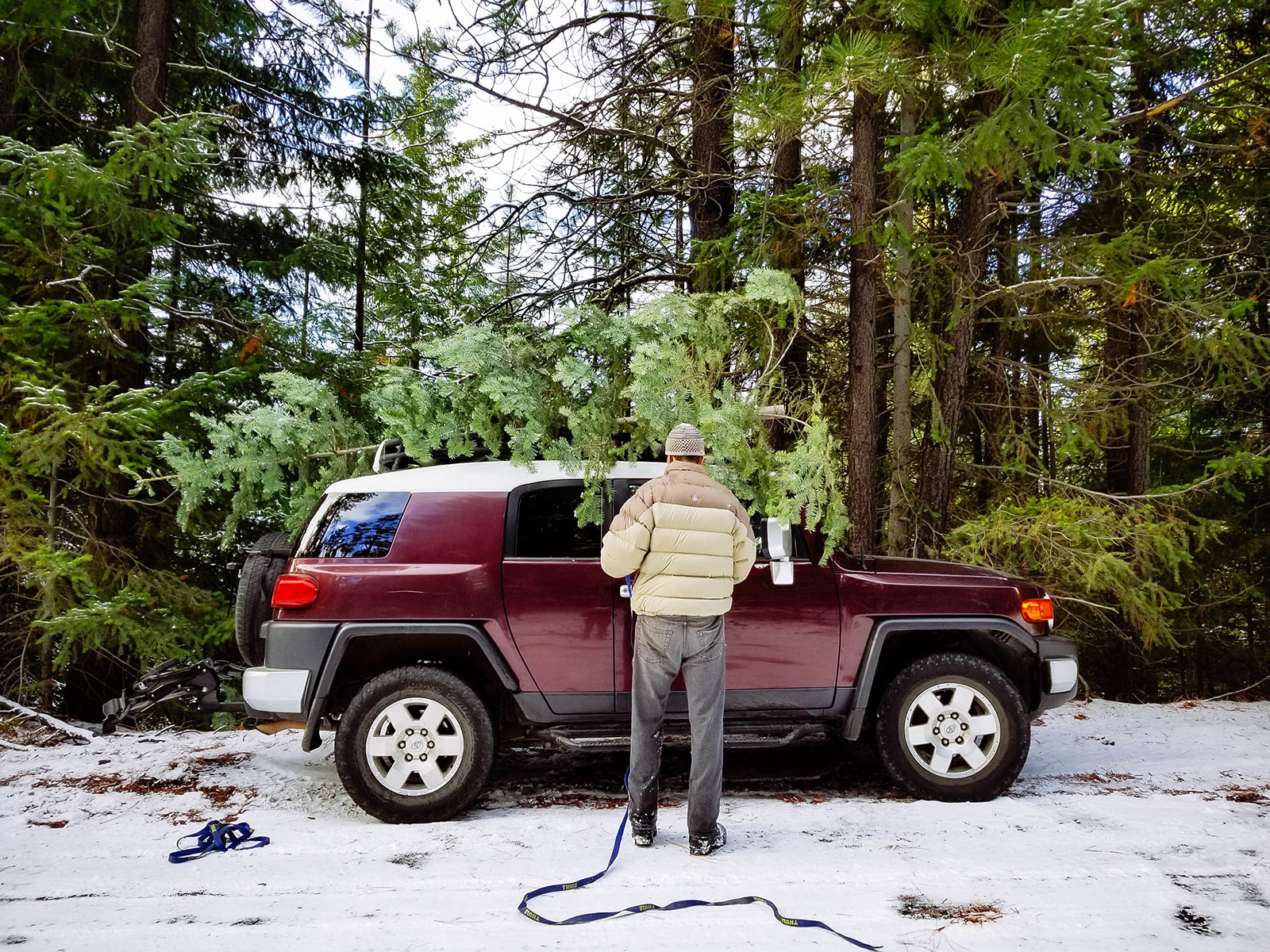













Since this article is feeding people information, it is most important to tell people the rules about cutting down a Christmas tree,yet nothing is mentioned in your article . Over the many years of cutting down my Christmas in the Deschutes national forest I have seen so many violations ..mostly due to ignorance and a sense of entitlement..Ive seen trees topped 2-10+ feet above the ground leaving the bottom portion for the tree to grow abnormally, Cutting close to forest roads, cutting close to lakes and streams or hiking paths, cutting trees considerably taller than 12 feet. Here are the added rules that should have been included in this article.
Tree selection:
You can only cut trees that are:
1)Less than 12 feet tall
2)Within 20 feet of another tree
3)Not a five-needle pine, sugar pine, or white pine
4)Cutting location
You can only cut trees on National Forest lands, and you can’t cut in:
1)Private property
2)Areas within 150 feet of state highways, campgrounds, and other developed areas
3)Areas within 300 feet of streams and bodies of water
4)Young tree plantations
5)Wilderness areas or the Newberry National Volcanic Monument
6)Experimental forests, research natural areas, or existing tree plantations
7)Active timber sales
8)Areas posted “No Christmas Tree Cutting”
Cutting practices
You must:
1)Cut stumps shorter than 12 inches
2)Take the whole tree
33)Not remove the top of the tree
4)Keep all debris at least 50 feet from roadways
The universal rules are listed right in my post, under a heading labeled clearly as “Rules for cutting a Christmas tree in a national forest.” I have plenty of information here if people take the time to read. Some of the rules also differ by forest district, but thank you for sharing the Deschutes NF guidelines here in the comments.
This article has bad information. It is illegal to cut down a tree(Christmas or otherwise)in Oregon without a permit. This article makes it seem as if you’d have no legal repercussion for cutting down a tree from a national forest, and that’s simply not true. You can purchase a “Christmas Tree Permit” online for roughly 8 dollars to avoid legal issues. Permits are issued by area so be sure you purchase one for the area you’ll be selecting your tree from.
She states that u must have a permit in the beginning and middle of the story. You obviously didn’t read it